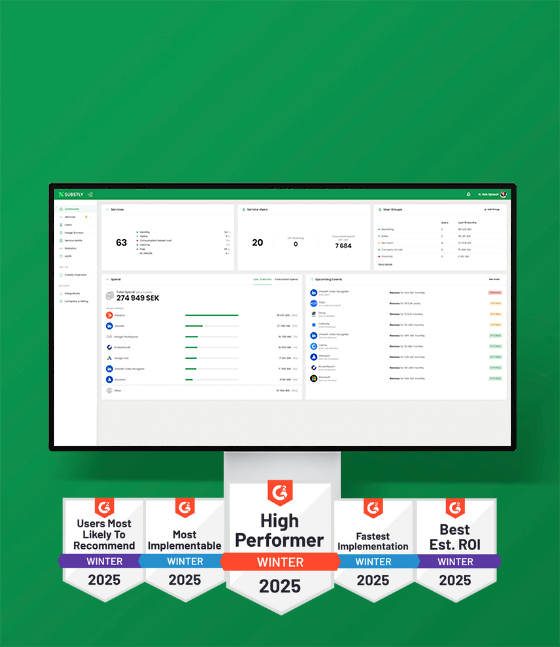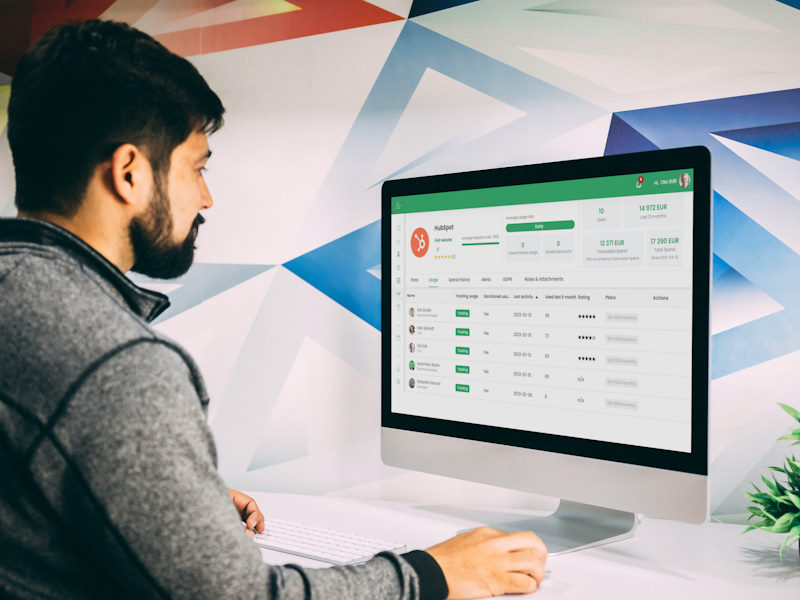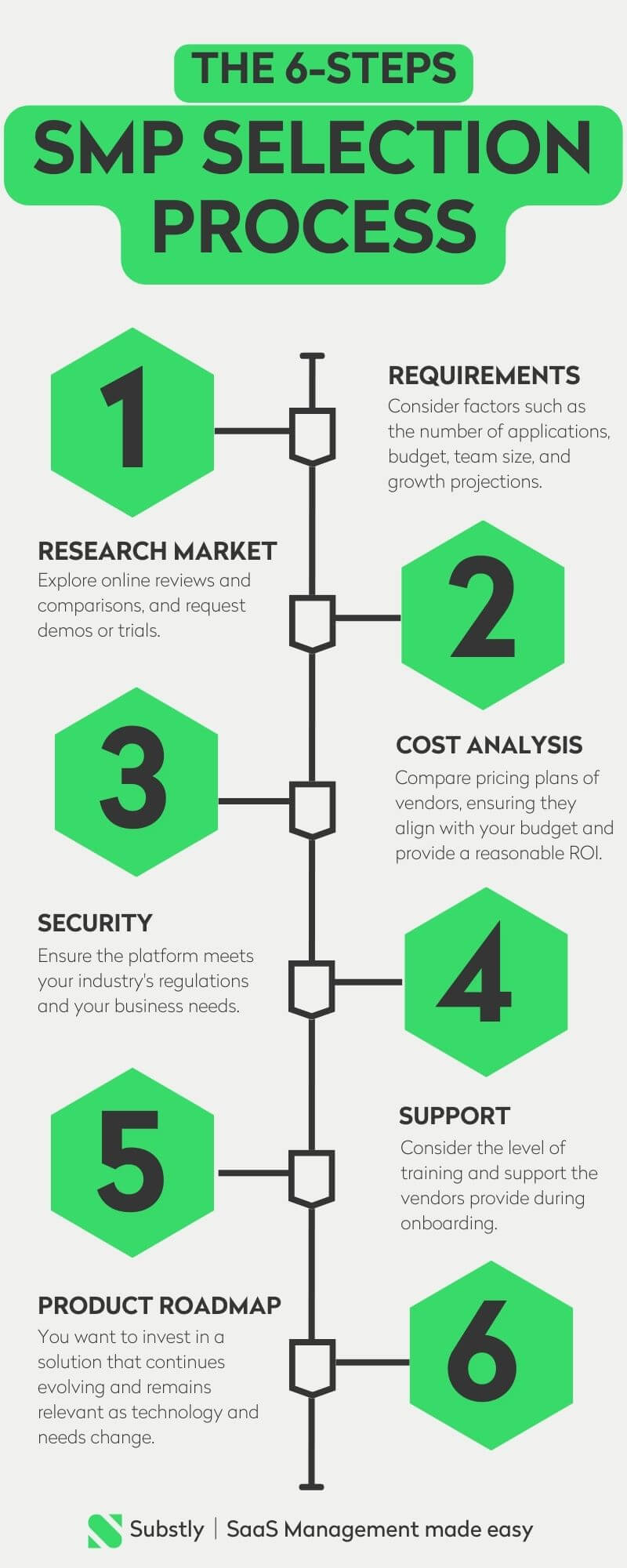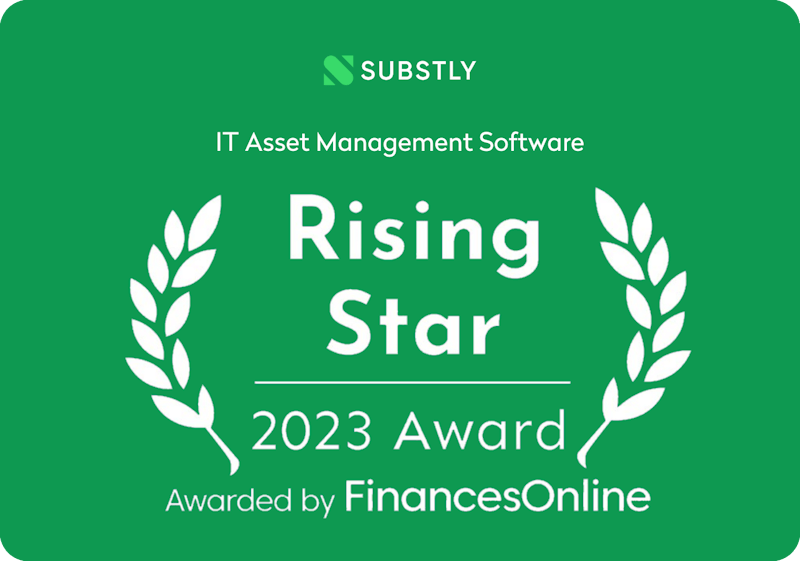Table of contents
What is a SaaS Management Platform?
Benefits of a SaaS Management Strategy and Platforms
Key Features of SMPs
When Should a SMB Invest in a SaaS Management Platform?
Challenges of Implementing a SMP
Differences between SMPs for Small Businesses and Enterprises
The 6-Step SMP Selection Process
Key Takeaways
- SaaS Management Platforms act as centralized control centers that offer a unified view of your entire SaaS ecosystem. These platforms streamline application visibility, usage tracking, streamlined on- & offboarding, and cost optimization.
- By leveraging these platforms strategically, companies can optimize their SaaS investments, boost productivity, fortify data security, and navigate compliance demands effectively.
- The decision of when to invest depends on factors such as rapid growth, the need for cost control, data security concerns, productivity enhancement, limited IT resources, and compliance demands.
- While the journey towards implementing a SaaS management strategy and platform might present challenges, from initial setup complexity and user adoption to integration issues and ongoing maintenance, the rewards far outweigh the obstacles.
In this comprehensive guide, we discuss the world of SaaS management platforms (SMPs), exploring their key features, benefits, and challenges, when you should consider investing in one, and how you go about finding the right fit.
What is a SaaS Management Platform?
In today's fast-evolving business landscape, where digital transformation is no longer a buzzword but a necessity, the reliance on Software as a Service (SaaS) applications has grown exponentially. These cloud-based applications bring unparalleled flexibility, scalability, and efficiency to companies of all sizes. However, as the number of SaaS applications being utilized by Small and Medium-sized Businesses (SMBs) surges, a new challenge arises: effectively managing this increasingly complex SaaS ecosystem.
This is where SMPs, or Saas Operations Management Platforms as they are also called, come into play. Picture them as the cockpit of a plane – a centralized control center where all critical information, insights, and actions related to an organization's SaaS applications converge. These platforms serve as a guiding compass, helping you to navigate the intricate SaaS landscape with precision and ease.
%20(1).png?width=500&height=488&name=kOsEizJ8jKs%20(3)%20(1).png)
At its core, a SaaS Management tool is designed to provide you with a comprehensive, holistic view of the entire SaaS ecosystem. This means easy access to a unified interface that offers insights into all the applications in use instead of grappling with scattered information and multiple dashboards. This visibility is invaluable; it allows you to pinpoint trends, uncover inefficiencies, and make informed decisions.
In a nutshell, SMPs are the glue that binds your SaaS ecosystem together. They offer a bird's-eye view of applications, enable efficient cost management and vendor management enhance security and compliance, automate workflows, and provide invaluable insights for strategic decision-making. For navigating the complex realm of the modern business environment, these platforms are the compass that ensures you stay on course toward growth and success.
Benefits of a SaaS Management Strategy and Platforms
Adopting a SaaS management strategy and platform yields many benefits contributing to your company's overall growth and stability.
Cost Savings are among the most tangible advantages. SMBs often find themselves juggling a multitude of subscriptions with varying pricing structures from different SaaS vendors. It's easy to lose track and end up overpaying for unused licenses. The ability to track application usage and identify underutilized or redundant subscriptions leads to substantial savings. SMBs often find themselves overpaying for licenses that are no longer essential. With a SaaS operations management platform, these inefficiencies are exposed and rectified, resulting in a leaner and more cost-effective software stack.
Enhanced Productivity is another goal of SaaS management. Without a centralized system, users struggle to locate the right applications or deal with access issues. This leads to precious time being wasted. A management platform ensures the right tools are readily accessible, enabling employees to focus on tasks that drive your business practices forward.
In the realm of Security, SaaS governance is a shield you can wield. In an era where data breaches can be catastrophic for companies financially and reputationally, having a system of record is crucial. SaaS management tools enable you to enforce security policies, keep sensitive data safe, and ensure compliance with regulations like GDPR or ISO. This proactive stance minimizes the risk of data breaches and the resulting damage to reputation and finances.
Managing user access and permissions across multiple applications from various SaaS vendors is a notorious pain point. Mundane and time-consuming tasks, such as provisioning licenses and managing approval processes, are streamlined, freeing up valuable human resources for more strategic endeavors than SaaS license management.
Streamlined On- and Offboarding is an HR-related benefit that these platforms bring to the table. Onboarding new staff members involves provisioning accounts for various applications, which is time-consuming and error-prone when done manually. SaaS operations management platforms ensure that new hires have the necessary tools from day one, enhancing their motivation, productivity, and integration into the team. Conversely, when people leave, their access can be promptly revoked, minimizing potential security risks.
SMBs operating in regulated industries face the ongoing challenge of maintaining Regulatory Compliance. Non-compliance can result in severe penalties. SaaS operations management platforms simplify compliance efforts by providing audit trails, tracking application usage, and ensuring that all software aligns with industry standards.
The power of Informed Decision-Making should not be underestimated. SaaS management tools provide actionable insights through data analytics. These insights empower you to make well-informed decisions about application usage, licensing, and vendor relationships. This data-driven approach enhances business strategies, helping you stay agile in a dynamic market.
Key Features of SMPs
The key features embedded in SaaS Management Platforms further amplify the above-mentioned benefits, creating a powerful toolkit that revolutionizes managing your SaaS ecosystem by becoming your strategic partner in a rapidly evolving business landscape.
One of the primary functionalities of these platforms is Application Visibility and Tracking. Imagine having a system of record that tracks application usage. After deploying SaaS tools, you can identify which are frequently utilized and which are collecting digital dust. This feature alone empowers you to identify redundant tools and those with low adoption rates. You can optimize your software portfolio and trim unnecessary expenses by pinpointing no longer essential applications.
Cost Optimization is a key driver for SMBs adopting these platforms. By monitoring subscription usage, these tools show which licenses to scale down or discontinue. This proactive approach to cost management empowers you to maximize your budget and invest strategically in applications that genuinely contribute to growth.
%20(1).png?width=500&height=384&name=KEyIVr5llKC%20(3)%20(1).png)
One of the challenges in a multi-SaaS environment is managing User Access and Permissions. SaaS operations management platforms simplify this by centralizing user management. Administrators can streamline the onboarding process for new employees, ensuring they have access to the necessary applications from day one. Similarly, access can be revoked swiftly when people leave, mitigating potential security risks.
Security and Compliance form the foundation of any robust SaaS ecosystem. SMPs bolster these aspects by enforcing security policies and offering compliance tracking features. With data breaches becoming increasingly common, maintaining stringent security measures is non-negotiable. Gartner states, "Organizations that fail to manage SaaS life cycles centrally will remain five times more susceptible to a cyber incident or data loss."
Automation is another noteworthy feature. Many SaaS operations management platforms facilitate workflows for tasks such as provisioning licenses, managing approvals, and handling employee transitions. This reduces manual effort and ensures consistency in processes, reducing the chances of errors that can lead to security vulnerabilities.
Moreover, these platforms offer Integration and Analytics capabilities. Integration with other tools ensures data flow between applications. This cross-platform connectivity enhances efficiency, provides a more unified user experience, and simplifies vendor management. The analytics component furnishes you with insights into usage patterns, helping you make informed decisions about application investments and potential optimizations.
When Should a SMB Invest in a SaaS Management Platform?
Several scenarios indicate it is time to up your SaaS governance game and consider investing in an SMP.
Rapid Growth often signifies the need for such a platform. As your operations expand, the number of SaaS applications quickly increases and becomes overwhelming. Managing them individually becomes impractical. A management platform provides a centralized solution that can scale along with your growth.
SaaS spend visibility has become a concern. Particularly when software costs start to escalate due to unused subscriptions and inefficient purchasing practices, implementing a SaaS operations management platform can rein in these expenses by identifying redundant subscriptions and give you insights into negotiating better deals.
Operating in an industry dealing with sensitive customer information or regulatory requirements leads to Data Security Concerns that are a significant driver. A management platform ensures that security policies are enforced consistently across all SaaS applications, minimizing the risk of data breaches.
When Enhanced Productivity is sought, a SaaS management tool will help. Employees wasting time navigating numerous applications can be detrimental to efficiency. A management platform streamlines workflows, ensuring employees spend more time on meaningful tasks and less on application management.
Small organizations with Limited IT Resources stand to benefit significantly from an SMP. These platforms' simplified administration allows small teams to manage a complex SaaS landscape effectively.
A SaaS management tool simplifies compliance efforts in industries with strict Audit and Reporting demands. The platform provides accurate records of application usage, making audits less cumbersome and reducing the risk of compliance violations.
Challenges of Implementing a SMP
While the benefits are substantial, implementing a SaaS management tool can present a few challenges you must be aware of and prepared for.
Initial Setup Complexity
Initial Setup Complexity is a hurdle that you might encounter. Integrating existing SaaS applications into the management platform requires careful planning and coordination. Depending on the applications' diversity and underlying infrastructure, this process might demand time and effort.
User Adoption
User Adoption can also be a stumbling block. Staff accustomed to their current workflows might initially resist changes brought about by a new management platform. Clear communication about the benefits and training sessions will help mitigate this resistance and accelerate user adoption.
Integration Issues
Integration issues might arise, especially when deploying SaaS tools that lack robust APIs or compatibility. Ensuring smooth integration between the management platform and various SaaS applications is one of the main challenges and requires technical expertise and custom solutions.
Dedicating Resources and Ongoing Maintenance
Dedicating Resources and Ongoing Maintenance are essential for the longevity of the management platform's effectiveness. Regular updates, license tracking, and user access management need consistent attention. Neglecting these tasks could lead to inaccurate insights, security vulnerabilities, and missed optimization opportunities.
-1.jpg?width=800&height=442&name=iHVnnLKx8%20(liten)-1.jpg)
Differences between SMPs for Small Businesses and Enterprises
When it comes to SMPs, one size doesn't fit all. Smaller companies' needs, complexities, and scale are distinct from those of larger enterprises. As a result, SaaS management tools are often tailored to cater to the unique requirements of these two categories. Let's explore the key differences between platforms targeting SMBs and those catering to larger enterprises:
SaaS Scale and Complexity
SMBs: SaaS management platforms designed for SMBs tend to be more straightforward and user-friendly, focusing on essential features such as cost optimization, basic security enforcement, and ease of integration. These platforms are built to accommodate the manageable number of applications typically used by SMBs.
Enterprises: Enterprises deal with a vast number of applications spread across different departments and locations. Consequently, enterprise SaaS management platforms are equipped to handle a higher degree of complexity. They offer advanced features for managing many applications, more intricate user access controls, and robust integration capabilities.
Customization and Flexibility
SMBs: Flexibility is key for SMBs, and their SaaS operations management platforms reflect this. These platforms often offer customization options that cater to the specific workflows and needs of SMBs. However, the customization might not be as extensive as that offered by enterprise-level platforms.
Enterprises: Enterprises often require highly customizable solutions due to the diversity of their operations. Enterprise-grade SMPs provide more customization to accommodate complex processes and integration requirements unique to larger organizations.
Security and Compliance
SMBs: While security and compliance are crucial for SMBs, the focus is often on essential security measures. SaaS management tools for SMBs generally offer foundational security features such as user access controls, usage monitoring, and compliance tracking.
Enterprises: Security and compliance are paramount for enterprises dealing with sensitive data and industry regulations. Enterprise-level platforms provide advanced security protocols, extensive data monitoring, and compliance tools to meet rigorous standards.
Integration Capabilities
SMBs: The integration needs are often not as complex. SMB-focused platforms offer integration capabilities that cater to their specific application landscape.
Enterprises: Enterprises require seamless integration between various applications to ensure efficient workflows across departments. Enterprise-level platforms offer robust integration capabilities to accommodate the diverse applications used within larger organizations.
Reporting and Analytics
SMBs: SMB-focused platforms offer reporting and analytics tools to help companies make informed decisions about cost optimization and application usage. However, the level of data granularity might not be as extensive as that offered by enterprise platforms.
Enterprises: Enterprises demand in-depth analytics and reporting capabilities to gain insights into their extensive application portfolio's utilization, performance, and cost efficiency. Enterprise platforms provide advanced analytics tools that cater to these requirements.
Pricing and Licensing
SMBs: Pricing models for SMB-oriented platforms are often structured to align with the budget constraints of smaller companies. These platforms are more affordable and often offer tiered pricing based on the number of applications or users.
Enterprises: Enterprise platforms usually have more complex pricing structures due to the extensive features and capabilities they offer. Pricing might be based on factors such as the number of users, applications, and additional customizations.
Support and Training
SMBs: SMB-focused platforms provide user-friendly interfaces and accessible support options tailored to the needs of smaller teams with limited IT resources.
Enterprises: Enterprise platforms often offer comprehensive training programs and dedicated support to cater to the complex needs of larger organizations with more extensive user bases.
The 6-Step SMP Selection Process
Investing in a SaaS operations management platform is a strategic decision for any company and requires careful consideration and research. With a plethora of options available in the market, it's essential to navigate the selection process thoughtfully to find the platform that aligns with your needs.
Here's a six steps best practice approach to guide you in finding and evaluating the best solution for your small or mid-sized company.
1. Assess Your Requirements
Before exploring the market, take time to understand your organization's specific requirements. Consider factors such as the number of SaaS applications you use, your budget, the size of your team, your growth projections, and any unique security or compliance needs.
2. Research the Market
Begin your search by researching the different SMPs available. Look for platforms that offer the key features that align with your requirements, such as application visibility, cost optimization, security enforcement, and automation. Explore online reviews and comparisons at sites like Capterra, Sourceforge, or G2 to gain insights into the strengths and weaknesses of each platform.
Don't rely solely on marketing materials or descriptions; request demos or trial periods. Hands-on experience with the tools will provide insight into their user-friendliness, functionality, and suitability for you.
3. Cost Analysis
While cost savings are an important goal of implementing a SaaS management tool, evaluating the platform's pricing structure is crucial. Compare the pricing plans of different vendors, ensuring they align with your budget and provide a reasonable return on investment.
4. Security and Compliance
Given the rising importance of data security and compliance, thoroughly assess each platform's security measures and compliance features. Ensure the platform meets your industry's regulations and your business needs.
5. Vendor Support and Training
Consider the level of training and support the vendor provides during onboarding. A platform is only as effective as the team using it. Adequate training ensures your team can utilize the platform's features to their fullest potential.
6. Long-Term Viability
Look at the vendor's roadmap and future plans for the platform. You want to invest in a solution that continues evolving and remains relevant as technology and needs change.
Make an Informed Decision
After thoroughly evaluating different platforms based on the above criteria, make an informed decision. Choose the platform that meets your current needs and positions your company for future growth and success.
If you work in a small or medium-sized business and seek a SaaS management platform with a short learning curve that is user-friendly and strengthens the cooperation between IT and Business, consider exploring Substly to see if it suits your needs.
Related articles
9 SaaS Management Best Practices for Small Businesses
SaaS Vendor Management: A Guide for Small and Medium-sized Businesses
SaaS Spend Management: A Guide for Small and Mid-sized Companies


.jpg?width=400&height=1000&name=6%20signs%20you%20need%20a%20SaaS%20management%20platform%20(4).jpg)



